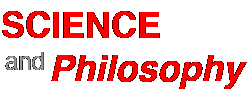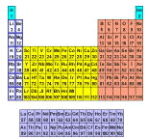Johnson, George “Challenging Particle Physics as Path to Truth” New York Times, 12/4/2001 [1800 words] — a new goal for physics research
In science's great chain of being, the particle physicists place themselves with the angels, looking down from the heavenly spheres on the chemists, biologists, geologists, meteorologists - those who are applying, not discovering nature's most fundamental laws. Everything, after all, is made from subatomic particles. Once you have a concise theory explaining how they work, the rest should just be filigree.
Even the kindred discipline of solid-state physics, which is concerned with the mass behavior of particles – what metals, crystals, semiconductors, whole lumps of matter do - is often considered a lesser pursuit. "Squalid state physics," Murray Gell-Mann, discoverer of the quark, dubbed it. Others dismiss it as "dirt physics."
Recently there have been rumblings from the muck. In a clash of scientific cultures, some prominent squalid-staters have been challenging the particle purists as arbiters of ultimate truth.
"The stakes here are very high," said Dr. Robert B. Laughlin, a Stanford University theorist who shared a Nobel Prize in 1998 for discoveries in solid-state physics. "At issue is a deep epistemological matter having to do with what physics is."
Last year Dr. Laughlin and Dr. David Pines, a theorist at the University of Illinois and Los Alamos National Laboratory, published a manifesto declaring that the "science of the past," which seeks to distill the richness of reality into a few simple equations governing subatomic particles, was coming to an impasse.
Many complex systems - the very ones the solid-staters study - appear to be irreducible. Made of many interlocking parts, they display a kind of synergy, obeying "higher organizing principles" that cannot be further simplified no matter how hard you try.
Carrying the idea even further, some solid-state physicists are trying to show that the laws of relativity, long considered part of the very bedrock of the physical world, are not platonic truths that have existed since time began.
They may have emerged from the roiling of the vacuum of space, much as supply-and-demand and other "laws" of economics emerge from the bustle of the marketplace. If so, then solid-state physics, which specializes in how emergent phenomena occur, may be the most fundamental science of them all.
"We're in the midst of a paradigm change," Dr. Pines said. "Ours is not the prevailing view, but I think it will turn out to be the one that lasts."
Working in this vein, one of Dr. Laughlin's Stanford colleagues, Dr. Shoucheng Zhang, recently was co-author of a paper suggesting that elementary particles like photons and gravitons, the carriers of electromagnetism and gravity, might not be so elementary after all - they might emerge as ripples in the vacuum of space, bubbling up from the quagmire in a way that can best be explained in terms of solid-state physics.
"The idea is of course crazy, thought provoking, and somewhat anti-establishment," Dr. Zhang said. "The main idea is to apply concepts from solid-state physics to answer some big questions of the universe."
The particle physicists insist that there is plenty of mileage left in their own approach. "I strongly believe that the fundamental laws of nature are not emergent phenomena," said Dr. David Gross, director of the Institute for Theoretical Physics at the University of California at Santa Barbara. "Bob Laughlin and I have violent arguments about this."
After hearing Dr. Zhang describe his theory at a seminar last month, Dr. Gross deemed it "an interesting piece of work." He said he found the mathematics "beautiful and intriguing, and perhaps of use somewhere."
That may sound like faint praise, but the particle physicists have reason to be wary. The squalid-staters are challenging them in a debate over how the universe is made and how science should be done.
Following the method of Plato, the particle physicists are inclined to see nature as crystallized mathematics. In the beginning was a single superforce, the embodiment of an elegant set of equations they call, only a bit facetiously, the theory of everything. Then along came the Big Bang to ruin it all.
The universe cooled and expanded, the single force splintering into the four very different forces observed today: electromagnetism and the weak and strong nuclear forces, which work inside atoms, are described by quantum mechanics and special relativity. The fourth force, gravity, is described by an entirely different theory, general relativity.
The particle physicists' ultimate goal is "grand unification" - recovering the primordial symmetry in the form of a single law - a few concise equations, it is often said, that could be silk-screened onto a T- shirt.
This approach, in which the most complex phenomena are boiled down to a unique underlying theory, is called reductionism.
The problem, the solid-staters say, is that many forms of matter - ranging from the exotic like superconductors and superfluids to the mundane like crystals and metals - cannot be described in terms of fundamental particle interactions. When systems become very complex, completely new and independent laws emerge. "More is different," as the Nobel laureate Philip W. Anderson put it in a landmark paper in 1972. To the solid-staters, it would take something the size of a circus tent to hold all the equations capturing the unruliness of the physical world.
Like Aristotle, they lean toward the notion that it is the equations that flow from nature instead of the other way around. Mathematics is just a tool for making sense of it all.
"For at least some fundamental things in nature, the theory of everything is irrelevant," declared Dr. Laughlin and Dr. Pines in the Jan. 4, 2000 issue of The Proceedings of the National Academy of Sciences. "The central task of theoretical physics in our time is no longer to write down the ultimate equations but rather to catalog and understand emergent behavior in its many guises, including potentially life itself."
There may not be a theory of everything, they say, just a lot of theories of things. This is exactly the kind of squalor the particle physicists abhor.
Dr. Grigori E. Volovik, a solid- state physicist at the Helsinki University of Technology in Finland, champions an idea he calls "anti- grand unification." In a review article last year (xxx.lanl.gov/abs /gr-qc/0104046), he ventured that the universe may have begun not in a state of pristine symmetry but in one of lawlessness. The laws of relativity and perhaps quantum mechanics itself would have emerged only later on.
The notion of emergent laws is not radical in itself. A flask of gas consists of trillions of molecules randomly colliding with one another. From this disorder, qualities like temperature and pressure emerge, along with laws relating one to the other.
To take that idea a level deeper. Physicists now believe that the vacuum of space is, paradoxically, not vacuous at all. It seethes with energy, in the form of "virtual particles" constantly flitting in and out of existence. So perhaps, Dr. Volovik suggests, even laws now considered fundamental emerged from this constant subatomic buzz.
Solid-state physics offers clues to how something like this might occur. The atomic vibrations that ripple through matter are, like all quantum phenomena, carried by particles - called, in this case, phonons.
Just as photons carry light and gravitons carry gravity, phonons carry the subatomic equivalent of sound. Like bubbles in a carbonated beverage, phonons - physicists call them "quasi particles" - appear only when the medium is disturbed. In the world of solid-state physics, quasi particles abound. In some substances, like the semiconductors used to make computer chips, the displacement of an electron leaves behind a "hole" that behaves like a positively charged particle. An electron and a hole can sometimes stick together to form a chargeless quasi particle called an exciton. Other such ephemera include magnons and polarons.
Evanescent though they are, quasi particles act every bit like elementary particles, obeying the laws of quantum mechanics. This has led some mavericks to wonder whether there is really any difference at all. Maybe elementary particles are just quasi particles - an effervescence in the vacuum.
Particularly intriguing is a phenomenon, occurring at extremely low temperatures, called the fractional quantum Hall effect. In certain substances, quasi particles appear that act curiously like electrons but with one-third the normal charge. (Dr. Laughlin won his Nobel Prize for a theory explaining this.)
Quarks, the basic building blocks of matter, also carry a one-third charge, a coincidence that has fueled speculation that emergence may be somehow fundamental to the very existence of the physical world.
A stumbling block to carrying this idea further has been that the quantum Hall effect seems to work only in two-dimensions - on the surface of a substance. But in a paper published in the Oct. 26 issue of Science, Dr. Zhang and his student Jiangping Hu showed how to extend the phenomenon. In their scheme, the physical world would be a three-dimensional "surface" of a four-dimensional "quantum liquid" - an underlying sea of particles that can be thought of as the vacuum.
Analyzing the ripples that would appear in such a medium, the two scientists were surprised to find that they mathematically resembled electromagnetic and gravitational waves. But there are problems with the model. At this point, the hypothetical photons and gravitons that emerge from the equations do not interact with other particles, as they do in the real world.
"The coupling is zero, so apples are weightless, as is everything else," said Dr. Joseph Polchinski, a string theorist at the University of California at Santa Barbara, who recently discussed the model with Dr. Zhang.
And there is what the theory's inventors concede is an "embarrassment of riches" - the equations predict hordes of exotic particles that do not exist.
"The hope is that some modification of the theory, not yet specified in detail, will remove the extra fields and turn on the coupling," Dr. Polchinski said. "Whether this can be done is at this point a guess. Overall my attitude now is interest with a high degree of skepticism."
If the theory can be made to work, it may point to a new way of unifying quantum mechanics and relativity. But Dr. Zhang is careful not to oversell what he considers a work in progress.
"Our work only made a tiny step toward this direction," Dr. Zhang said, "but it seems to indicate that the goal may not be impossible to reach." At the very least, he said, his work may inspire more collaboration between particle physicists and solid-staters.
Ultimately, though, the two sides know that they are talking across a divide. Taken to its extreme, emergence suggests that all the fundamental laws, even quantum mechanics, may be secondary - that at the base of reality is random noise.
Dr. Polchinski said he found that idea discouraging. "To me, the history of science seems to be a steady progression toward simpler and more unified laws, and I expect to see this continue and to contribute to it. Things may take many surprising twists and turns," he said, "but we reductionists are still quite happily and busily reducing."


